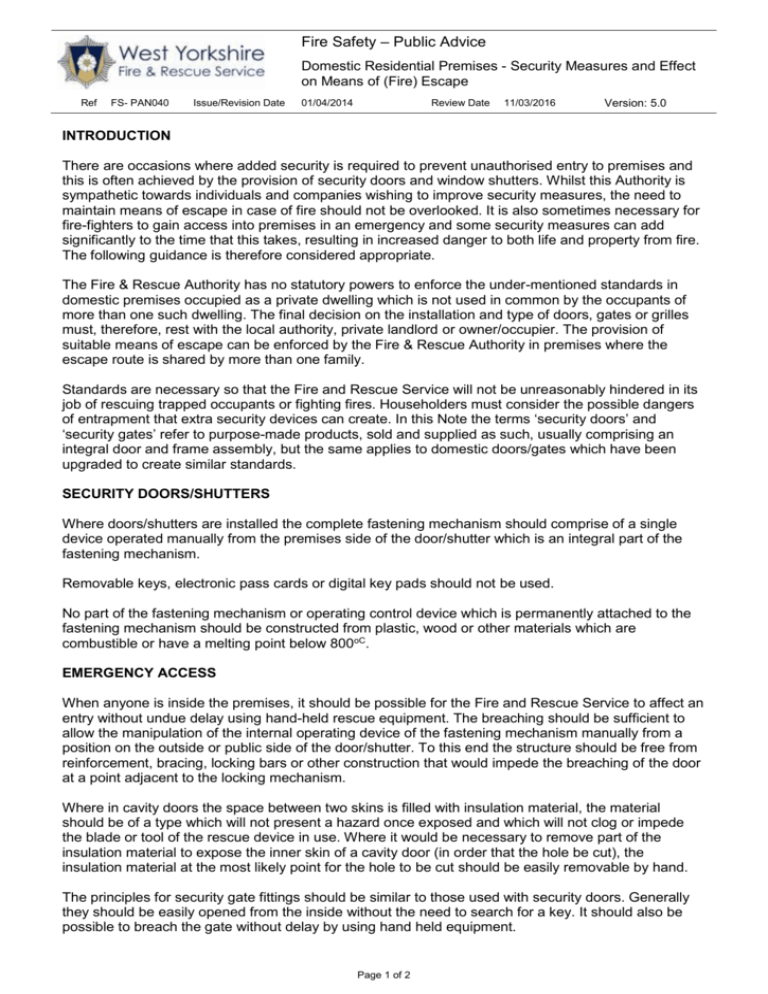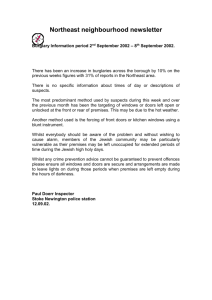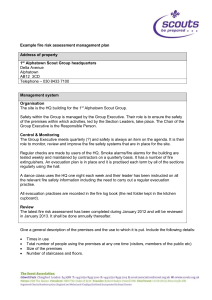Domestic Residential Premises - Security Measures and Effect on
advertisement

Fire Safety – Public Advice Domestic Residential Premises - Security Measures and Effect on Means of (Fire) Escape Ref FS- PAN040 Issue/Revision Date 01/04/2014 Review Date 11/03/2016 Version: 5.0 INTRODUCTION There are occasions where added security is required to prevent unauthorised entry to premises and this is often achieved by the provision of security doors and window shutters. Whilst this Authority is sympathetic towards individuals and companies wishing to improve security measures, the need to maintain means of escape in case of fire should not be overlooked. It is also sometimes necessary for fire-fighters to gain access into premises in an emergency and some security measures can add significantly to the time that this takes, resulting in increased danger to both life and property from fire. The following guidance is therefore considered appropriate. The Fire & Rescue Authority has no statutory powers to enforce the under-mentioned standards in domestic premises occupied as a private dwelling which is not used in common by the occupants of more than one such dwelling. The final decision on the installation and type of doors, gates or grilles must, therefore, rest with the local authority, private landlord or owner/occupier. The provision of suitable means of escape can be enforced by the Fire & Rescue Authority in premises where the escape route is shared by more than one family. Standards are necessary so that the Fire and Rescue Service will not be unreasonably hindered in its job of rescuing trapped occupants or fighting fires. Householders must consider the possible dangers of entrapment that extra security devices can create. In this Note the terms ‘security doors’ and ‘security gates’ refer to purpose-made products, sold and supplied as such, usually comprising an integral door and frame assembly, but the same applies to domestic doors/gates which have been upgraded to create similar standards. SECURITY DOORS/SHUTTERS Where doors/shutters are installed the complete fastening mechanism should comprise of a single device operated manually from the premises side of the door/shutter which is an integral part of the fastening mechanism. Removable keys, electronic pass cards or digital key pads should not be used. No part of the fastening mechanism or operating control device which is permanently attached to the fastening mechanism should be constructed from plastic, wood or other materials which are combustible or have a melting point below 800oC. EMERGENCY ACCESS When anyone is inside the premises, it should be possible for the Fire and Rescue Service to affect an entry without undue delay using hand-held rescue equipment. The breaching should be sufficient to allow the manipulation of the internal operating device of the fastening mechanism manually from a position on the outside or public side of the door/shutter. To this end the structure should be free from reinforcement, bracing, locking bars or other construction that would impede the breaching of the door at a point adjacent to the locking mechanism. Where in cavity doors the space between two skins is filled with insulation material, the material should be of a type which will not present a hazard once exposed and which will not clog or impede the blade or tool of the rescue device in use. Where it would be necessary to remove part of the insulation material to expose the inner skin of a cavity door (in order that the hole be cut), the insulation material at the most likely point for the hole to be cut should be easily removable by hand. The principles for security gate fittings should be similar to those used with security doors. Generally they should be easily opened from the inside without the need to search for a key. It should also be possible to breach the gate without delay by using hand held equipment. Page 1 of 2 Security doors and security gates should not be installed together at the same access point to the premises. Therefore, no more than one security door or gate should need to be breached to gain access to any dwelling. Where there is concern that a proposed security device will cause an excessive delay to the Fire and Rescue Service when affecting an entry, details of the premises and the proposals should be passed to your local fire station before installation. WINDOW SECURITY GRILLES Non-openable external/internal grilles should not be fitted to the windows of premises that have security doors/gates to the main entrance. All window grilles should have openable area of sufficient dimensions to facilitate escape for the occupiers in the event of any emergency (see below). All grilles should be easily opened from the inside without the need to search for a key. ROLLER SHUTTERS/SECONDARY STEEL DOORS Roller shutters and secondary steel doors are not recommended as a means of security other than when premises are unoccupied. Where these have been installed on unoccupied dwellings they should be removed before any future occupancy is allowed. DOUBLE GLAZING (FIXED OR SECONDARY) When fitting double-glazing the following advice from Approved Document B (Section 2) of the Building Regulations 2000 should be followed “Except for kitchens, all habitable rooms in the upper storey(s) of a house served by only one stair should be provided with an openable window (or external door). A window should have an unobstructed openable area that is at least 0.33m2 and at least 450mm high and 450mm wide (the route through the window may be at an angle rather than straight through). The bottom of the openable area should be not more than 1100mm above the floor. The window(s) concerned should be opened from the inside without the need to search for a key. SMOKE ALARMS In all instances where any of the above security measures are taken it is most strongly recommended that smoke alarms be fitted within the premises. The smoke alarms should be so arranged as to be audible in all rooms of the dwelling and of sufficient audibility to raise occupants from their sleep. It may be wise to fit the type of alarms that can be linked together so that the activation of any one unit activates all the others in the premises. Smoke alarms for individual dwellings should comply with BS 5446: Part 1. Smoke alarms for larger premises should be installed as part of a fire alarm and detection system complying with BS 5839. For further Public Advice leaflets from the West Yorkshire Fire and Rescue Service visit: http://www.westyorksfire.gov.uk – Your Safety – Safety Leaflets Page 2 of 2






